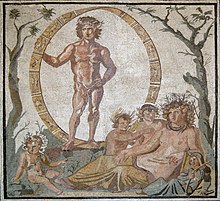
Back تيرا (أسطورة) Arabic Тэлус Byelorussian Тера Bulgarian Tellus Breton Tera BS Tel·lus Catalan Tellus Czech Tellus (mytologi) Danish Tellus German Tellus Spanish
| Terra | |
|---|---|
The personification of the Earth | |
 | |
| Other names | Tellus |
| Abode | Earth |
| Symbol | Fruit, flowers, cornucopia, cattle |
| Personal information | |
| Parents | Chaos Aether and Dies (Hyginus) |
| Siblings | Caelus (Hyginus) |
| Consort | Caelus |
| Children | Saturn, Ops, Janus |
| Equivalents | |
| Greek equivalent | Gaia |
| Indo-European equivalent | Dʰéǵʰōm |
| Albanian equivalent | Dhé[1] |
In ancient Roman religion and mythology, Tellus Mater or Terra Mater[a] ("Mother Earth") is the personification of the Earth. Although Tellus and Terra are hardly distinguishable during the Imperial era,[2] Tellus was the name of the original earth goddess in the religious practices of the Republic or earlier.[3][4] The scholar Varro (1st century BC) lists Tellus as one of the di selecti, the twenty principal gods of Rome, and one of the twelve agricultural deities.[5][6]: 7.2 She is regularly associated with Ceres in rituals pertaining to the earth and agricultural fertility.
The attributes of Tellus were the cornucopia, bunches of flowers, or fruit. She was typically depicted reclining, or rising, waist high, from a hole in the ground.[7] Her male complement was a sky god such as Caelus (Uranus) or a form of Jupiter. Her Greek counterpart is Gaia,[8] and among the Etruscans her name was Cel. Michael Lipka has argued that the Terra Mater who appears during the reign of Augustus is a direct transfer of the Greek Ge Mater into Roman religious practice, while Tellus, whose ancient temple was within Rome's sacred boundary (pomerium), represents the original earth goddess cultivated by the state priests.[9]: 151–152 ff
- ^ Ushaku, Ruzhdi (1988). "Mbi strukturën leksiko-semantike dhe etimologjike të tipit të togfjalëshit të shqipes burri i dheut (Mundësia për një rindërtim)". Gjurmime Albanologjike. 17–18: 63–76. pp=92, 95–97.
- ^ Augoustakis, Antony (2010). Motherhood and the Other: Fashioning female power in Flavian epic. Oxford University Press. p. 124. ISBN 978-0-19-958441-3.
- ^ Forsythe, Gary (2012). Time in Roman Religion: One thousand years of religious history. Routledge. p. 73.
- ^ McDonough, Christopher M. (2010). "Roman Religion". The Oxford Encyclopedia of Ancient Greece and Rome. Vol. 1. Oxford University Press. p. 97.
- ^ Cite error: The named reference
Varro_de_rewas invoked but never defined (see the help page). - ^ Cite error: The named reference
Augustine_Civwas invoked but never defined (see the help page). - ^ Lawrence, Marion (1965). "The Velletri Sarcophagus". American Journal of Archaeology. 69 (3): 212. doi:10.2307/502285. JSTOR 502285. S2CID 193124610.
- ^ Haydock (1995). Larousse Desk Reference Encyclopedia. The Book People. p. 215.[full citation needed]
- ^ Lipka, Michael (2009). Roman Gods: A conceptual approach. Brill.
Cite error: There are <ref group=lower-alpha> tags or {{efn}} templates on this page, but the references will not show without a {{reflist|group=lower-alpha}} template or {{notelist}} template (see the help page).
© MMXXIII Rich X Search. We shall prevail. All rights reserved. Rich X Search